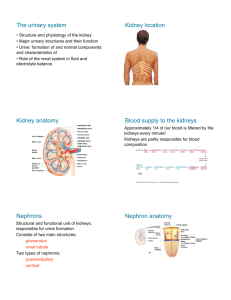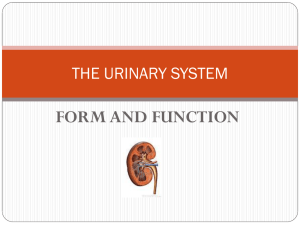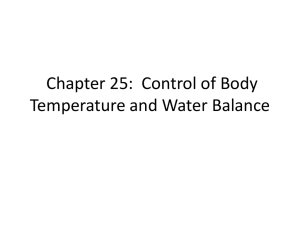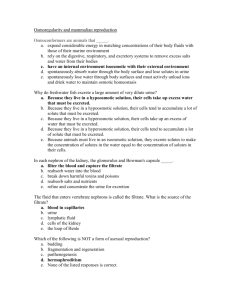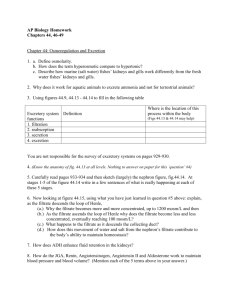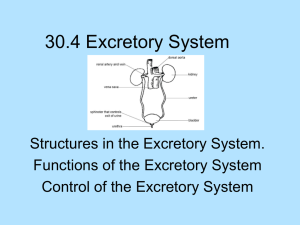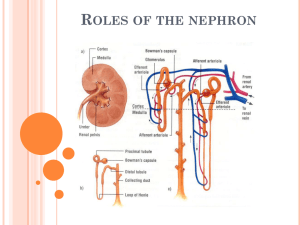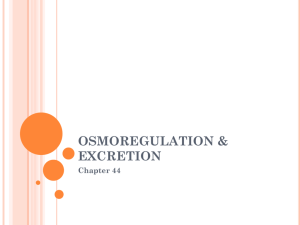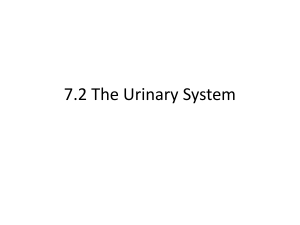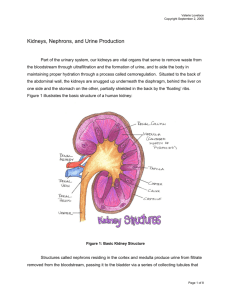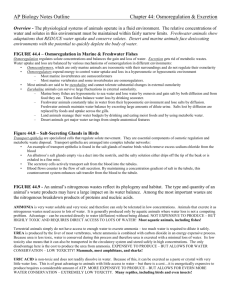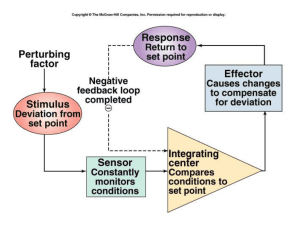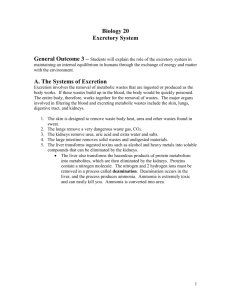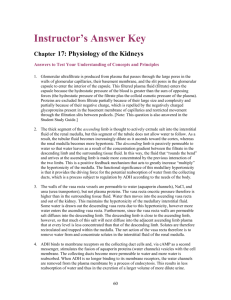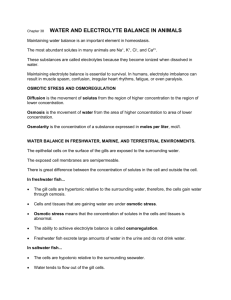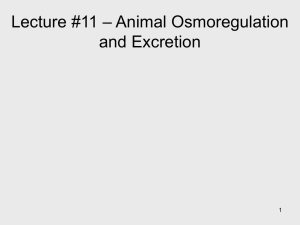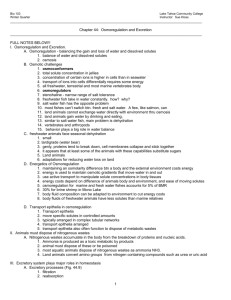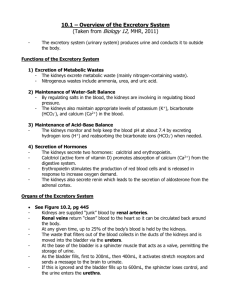Chapter 25: Control of Body Temperature and Water Balance 25.1
advertisement
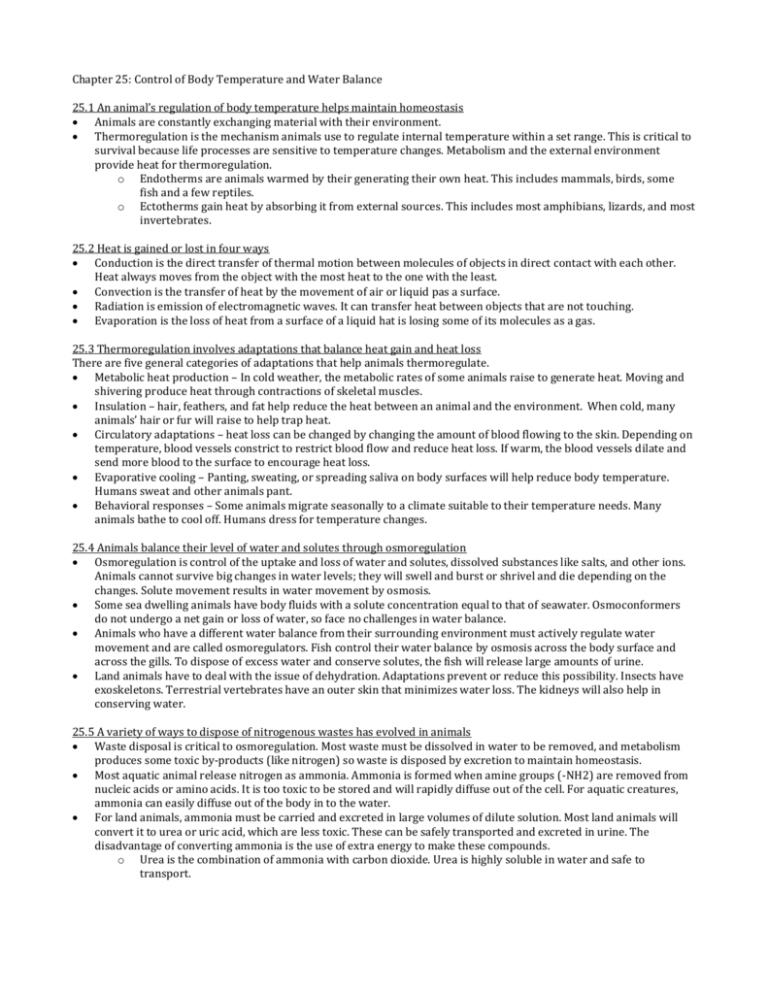
Chapter 25: Control of Body Temperature and Water Balance 25.1 An animal’s regulation of body temperature helps maintain homeostasis Animals are constantly exchanging material with their environment. Thermoregulation is the mechanism animals use to regulate internal temperature within a set range. This is critical to survival because life processes are sensitive to temperature changes. Metabolism and the external environment provide heat for thermoregulation. o Endotherms are animals warmed by their generating their own heat. This includes mammals, birds, some fish and a few reptiles. o Ectotherms gain heat by absorbing it from external sources. This includes most amphibians, lizards, and most invertebrates. 25.2 Heat is gained or lost in four ways Conduction is the direct transfer of thermal motion between molecules of objects in direct contact with each other. Heat always moves from the object with the most heat to the one with the least. Convection is the transfer of heat by the movement of air or liquid pas a surface. Radiation is emission of electromagnetic waves. It can transfer heat between objects that are not touching. Evaporation is the loss of heat from a surface of a liquid hat is losing some of its molecules as a gas. 25.3 Thermoregulation involves adaptations that balance heat gain and heat loss There are five general categories of adaptations that help animals thermoregulate. Metabolic heat production – In cold weather, the metabolic rates of some animals raise to generate heat. Moving and shivering produce heat through contractions of skeletal muscles. Insulation – hair, feathers, and fat help reduce the heat between an animal and the environment. When cold, many animals’ hair or fur will raise to help trap heat. Circulatory adaptations – heat loss can be changed by changing the amount of blood flowing to the skin. Depending on temperature, blood vessels constrict to restrict blood flow and reduce heat loss. If warm, the blood vessels dilate and send more blood to the surface to encourage heat loss. Evaporative cooling – Panting, sweating, or spreading saliva on body surfaces will help reduce body temperature. Humans sweat and other animals pant. Behavioral responses – Some animals migrate seasonally to a climate suitable to their temperature needs. Many animals bathe to cool off. Humans dress for temperature changes. 25.4 Animals balance their level of water and solutes through osmoregulation Osmoregulation is control of the uptake and loss of water and solutes, dissolved substances like salts, and other ions. Animals cannot survive big changes in water levels; they will swell and burst or shrivel and die depending on the changes. Solute movement results in water movement by osmosis. Some sea dwelling animals have body fluids with a solute concentration equal to that of seawater. Osmoconformers do not undergo a net gain or loss of water, so face no challenges in water balance. Animals who have a different water balance from their surrounding environment must actively regulate water movement and are called osmoregulators. Fish control their water balance by osmosis across the body surface and across the gills. To dispose of excess water and conserve solutes, the fish will release large amounts of urine. Land animals have to deal with the issue of dehydration. Adaptations prevent or reduce this possibility. Insects have exoskeletons. Terrestrial vertebrates have an outer skin that minimizes water loss. The kidneys will also help in conserving water. 25.5 A variety of ways to dispose of nitrogenous wastes has evolved in animals Waste disposal is critical to osmoregulation. Most waste must be dissolved in water to be removed, and metabolism produces some toxic by-products (like nitrogen) so waste is disposed by excretion to maintain homeostasis. Most aquatic animal release nitrogen as ammonia. Ammonia is formed when amine groups (-NH2) are removed from nucleic acids or amino acids. It is too toxic to be stored and will rapidly diffuse out of the cell. For aquatic creatures, ammonia can easily diffuse out of the body in to the water. For land animals, ammonia must be carried and excreted in large volumes of dilute solution. Most land animals will convert it to urea or uric acid, which are less toxic. These can be safely transported and excreted in urine. The disadvantage of converting ammonia is the use of extra energy to make these compounds. o Urea is the combination of ammonia with carbon dioxide. Urea is highly soluble in water and safe to transport. o Uric acid is mostly insoluble in water and is generally excreted as a semisolid paste, such as that of bird droppings. This does save water, but uric acid is a complex molecule and takes more energy to excrete than urea. 25.6 The urinary system plays several major roles in homeostasis The urinary system helps maintain homeostasis by forming and excreting urine while regulating the amount of water in body fluids. The main organs of the system are the 2 kidneys. The kidneys contain a network of tubules and capillaries. The body contains about 5L of blood that are circulated continuously through the kidneys where about 180L of fluid, filtrate, are removed. This includes water, urea, and solutes including glucose, amino acids, vitamins, and ions. If the filtrate was all excreted, we would dehydrate and lose nutrients. Filtrate is reprocessed and the solutes are returned. About 1.5 L of fluid are excreted daily. Blood for filtration enters the kidneys through the renal artery, while blood that has been filtered leaves from the renal vein. Urine leaves the kidney through a ureter, where it travels to the urinary bladder for expulsion through the urethra. Sphincter muscles between the bladder and urethra control urination. The kidney has two main regions: the renal cortex and renal medulla. The functional units of the kidneys are termed nephrons. A nephron extracts filtrate from the blood and refines it into urine. Each nephron starts and ends in the cortex, some will extend in to the medulla. The receiving end of a nephron is called Bowman’s capsule. The other end is called the collecting duct. A Bowman’s capsule has a ball of capillaries called a glomerulus, and these two work together as the blood filtering unit. A nephron has 3 sections: o Proximal tubule o Loop of Henle that carries the filtrate towards the medulla and back in to the cortex o Distal tubule that drains into a collecting duct 25.7 Overview: The key processes of the urinary system are filtration, reabsorption, secretion and excretion Filtration – the pressure of blood forces water and other small molecules through a capillary wall into the start of a kidney tubule, forming filtrate Reabsorption – water and solutes are reclaimed from filtrate Secretion – substances in the blood are transported into the filtrate. This also eliminates some drugs and toxins from blood. Excretion – urine passes from the kidneys 25.8 Blood filtrate is refined to urine through reabsorption and secretion The proximal tubule actively transports nutrients from the filtrate into the interstitial fluid for reabsorption. Salt is reabsorbed and water will follow it by osmosis. The loop of Henle carries the filtrate in to the medulla and back in to the cortex. Water leaves the tubule because the fluid in the medulla has a higher solute concentration than the filtrate. It will move into nearby capillaries and be recycled. Final refining occurs in the collecting duct. It actively reabsorbs NaCl and determines how much salt is released in urine. As filtrate moves through the duct, more water is reabsorbed before urine passes in to the renal pelvis. This water conservation is an important function of the kidney. 25.9 Hormones regulate the urinary system Body control of water and solutes is maintained by increasing or decreasing the levels of hormones that act on the nephrons. Antidiuretic hormone (ADH) signals the kidneys to reabsorb water when solute levels are too high. Reabsorption of water increases the amount of water returning to the blood. If water levels are high, then the amount of ADH releases is lowered. Caffeine is also a diuretic. 25.10 Kidney dialysis can be lifesaving A person can survive with one functional kidney, but not without kidneys. Buildup of wastes and lack of regulation cause death. More than 60% of cases of kidney disease are caused by hypertension or diabetes. Other causes include extended use of pain relievers (even over the counter ones), alcohol, or other drugs. Dialysis the artificial filtering of blood using machines. This technique will be used when the kidneys are damaged. The patient’s blood is passed through a series of selectively permeable tubes that remove built up wastes. Dialysis can save the life of a person with kidney failure, but takes 4-6 hours every 3 weeks and must be continued until the kidney is replaced. Average wait time for a kidney in the US is 3-5 years.
